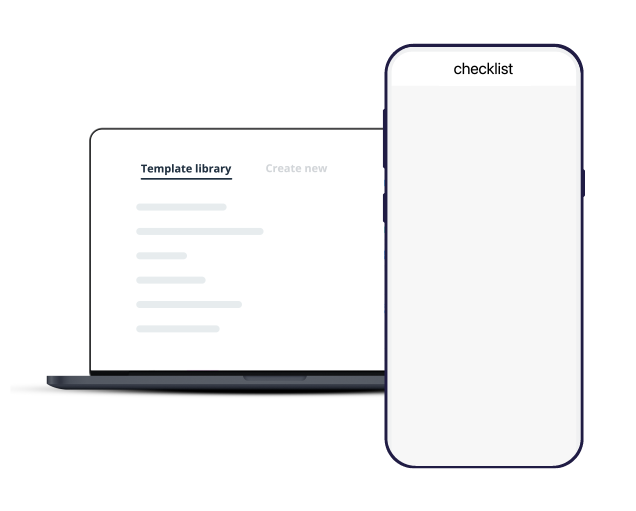Use our construction inspection checklist template as a starting point to customize yours to fit your company.
Construction Inspection Checklist (for Heavy Machinery and Hand-Held Tools)

Make work flow with Connecteam’s digital forms & checklists
- Easily create digital forms and checklists for any task your team needs to complete on the job
- Boost accountability by having employees add a signature, image, or location stamp
- Save time by choosing from a variety of ready-made templates
- Instantly receive your team’s submissions and share reports within your organization
- Use AI to convert PDFs, Excel files, or images into digital forms in seconds—no manual work needed

Construction Inspection Checklist (for Heavy Machinery and Hand-Held Tools)
This comprehensive inspection checklist is designed to ensure the safe and efficient operation of various types of equipment used on construction sites, including both heavy machinery and hand-held tools.
Regular inspections are essential for identifying potential issues, preventing accidents, and maintaining compliance with safety regulations.
By using this checklist, inspectors can conduct thorough assessments of construction equipment and hand-held tools, promoting a culture of safety and excellence across all construction activities.
General Inspection:
[ ] Verify the equipment’s identification and serial number (if applicable).
[ ] Check the equipment’s overall condition for signs of damage or wear.
[ ] Inspect for visible leaks of fuel, oil, coolant, or hydraulic fluid.
[ ] Verify that all safety decals, warning labels, and safety instructions are present and legible.
[ ] Check for any modifications or unauthorized alterations to the equipment or tool.
Fluid Levels (if applicable):
[ ] Check engine oil level and condition (for applicable equipment).
[ ] Inspect hydraulic fluid level and quality (for applicable equipment).
[ ] Verify coolant level and concentration (for applicable equipment).
[ ] Check fuel level and inspect for contamination.
Mechanical Components:
[ ] Inspect tires, tracks, or wheels for wear and proper inflation (if applicable).
[ ] Check the condition of belts, hoses, and chains.
[ ] Verify the operation and condition of brakes (if applicable).
[ ] Inspect the condition of the suspension and shock absorbers (if applicable).
[ ] Check for excessive vibration or unusual noises during operation.
Electrical Components (for applicable equipment and tools):
[ ] Verify the functionality of all lights (headlights, taillights, indicators).
[ ] Check the operation of warning alarms and backup alarms (if applicable).
[ ] Inspect the battery and its connections for corrosion and proper voltage.
[ ] Test all switches and controls for proper functioning.
Operator’s Compartment (for applicable equipment):
[ ] Inspect the operator’s seat for damage and proper adjustments.
[ ] Check the condition of the seatbelt and ensure it latches securely.
[ ] Verify the functionality of the controls and gauges.
[ ] Inspect windows and mirrors for visibility and damage.
[ ] Check the operation of air conditioning and heating (if applicable).
Safety Features:
[ ] Verify the functionality of all safety devices (e.g., ROPS, FOPS, safety interlocks).
[ ] Check the operation of emergency stop buttons and emergency shutdown systems.
[ ] Inspect fire extinguisher(s) for proper charge and accessibility.
[ ] Ensure that all required safety guards and shields are in place for equipment and tools.
Attachments and Implements (for applicable equipment):
[ ] Inspect attachments for proper mounting and secure connections.
[ ] Verify the condition and sharpness of cutting edges and teeth (if applicable).
[ ] Check hydraulic connections for leaks and proper functionality (if applicable).
[ ] Inspect the condition of buckets, forks, blades, augers, or other attachments (if applicable).
Hand Grips and Controls (for hand-held tools):
[ ] Inspect handles or grips for damage and secure attachment to the tool.
[ ] Check the functionality of all control switches, triggers, and speed settings.
[ ] Ensure that handles provide a comfortable and ergonomic grip.
Safety Labels and Instructions:
[ ] Verify that all safety labels and warnings are present and legible for equipment and tools.
[ ] Review the equipment and tool user manuals and follow the manufacturer’s safety instructions.
Personal Protective Equipment (PPE):
[ ] Ensure that appropriate PPE, such as safety goggles, gloves, and hearing protection, is available and worn by users of equipment and tools.
[ ] Check that users are trained in the proper use and handling of the equipment and tools.
Work Area Inspection:
[ ] Inspect the work area for any potential hazards or obstacles for both equipment and hand-held tools.
[ ] Ensure adequate lighting for safe equipment and tool operation.
Documentation and Maintenance:
[ ] Verify that the equipment’s maintenance log is up-to-date.
[ ] Check service records for completed maintenance and repairs for both equipment and tools.
[ ] Ensure that all required inspections and certifications are current for equipment.
[ ] Review the equipment and tool user manuals and operating instructions.
Inspection Records:
[ ] Document the inspection findings, including any identified issues or deficiencies, for both equipment and tools.
[ ] Record the date and time of the inspection and the inspector’s name.
[ ] Indicate whether the equipment and tools passed or failed the inspection.
[ ] File the inspection report in a secure and accessible location.
By utilizing this construction equipment inspection checklist, construction teams can ensure the safety, reliability, and compliance of all equipment and tools used on construction sites.
Regular and thorough inspections promote a safe and productive work environment, reducing the risk of accidents and maximizing the efficiency of construction operations.
Remember to adapt this checklist based on the specific equipment and hand-held tools being inspected and schedule routine inspections based on usage and manufacturer’s recommendations.
Choose Connecteam, the #1 Choice for Safety Inspectors
Connecteam is the ultimate tool that can significantly enhance your performance, streamlining your tasks and boosting productivity.
With our user-friendly mobile app, you can easily create and access construction equipment inspection checklists, ensuring every aspect of the project is thoroughly examined.
Empower yourself with our real-time reporting feature, allowing you to document findings instantly, complete with photos and notes, and enabling efficient communication with project managers and stakeholders.
Plus, our smart employee scheduling and task management capabilities help you optimize work plans, ensuring timely inspections and minimizing delays.
Experience a game-changing solution tailored to your construction company’s needs!
Get started with Connecteam for free today and enjoy seamless checklists, instant reporting, and efficient collaboration with your team.
📚 This Might Interest You:
Watch the video below to see it in action:

Ready to boost your efficiency with our pre-made templates?